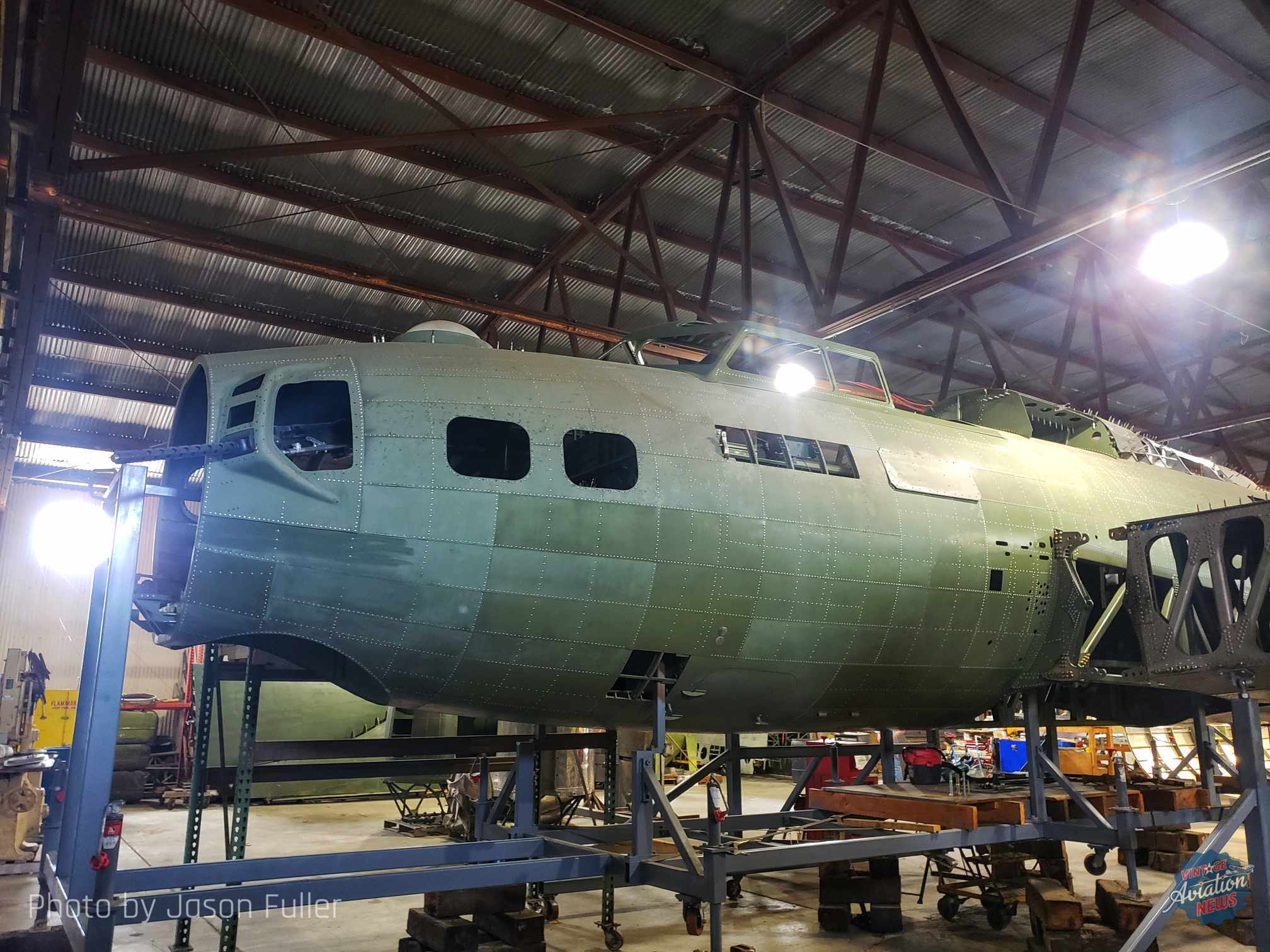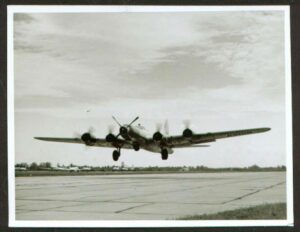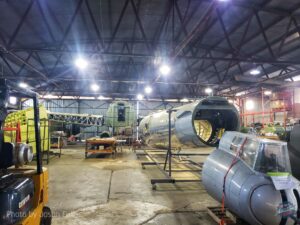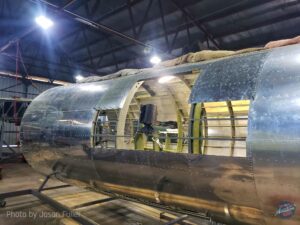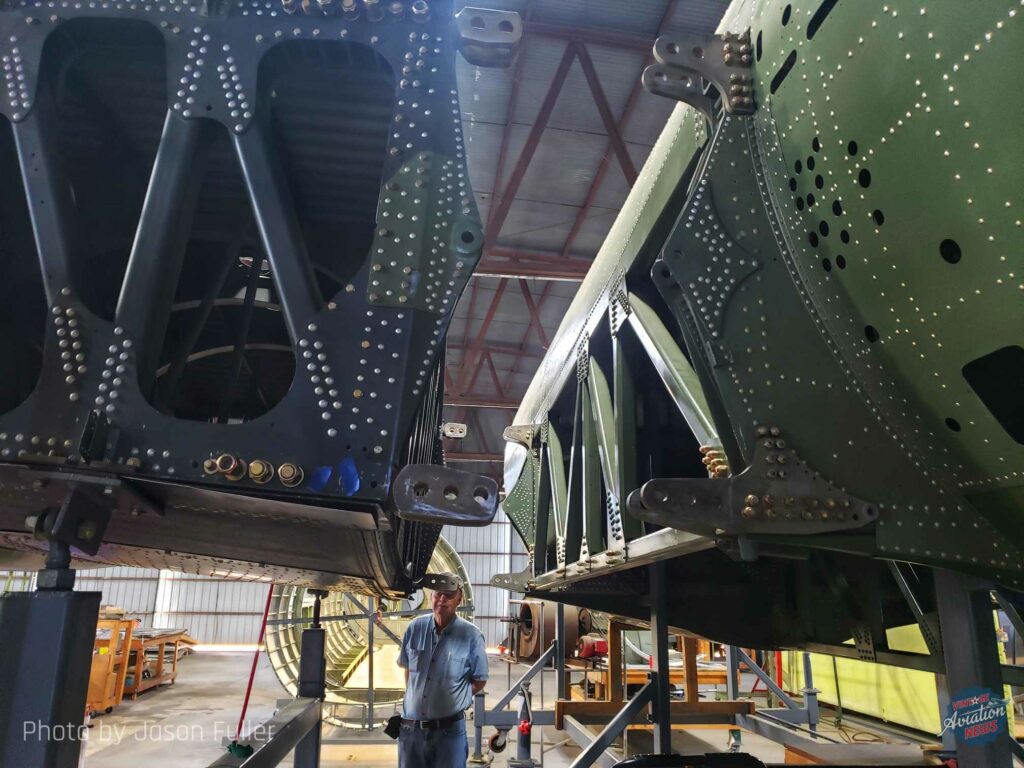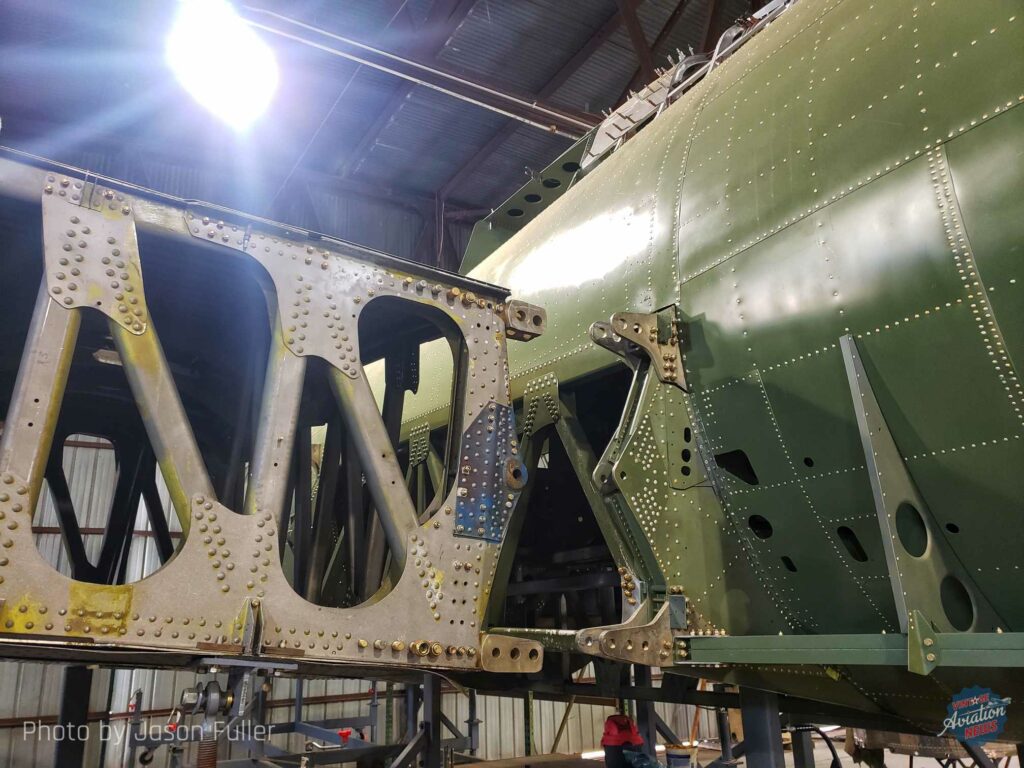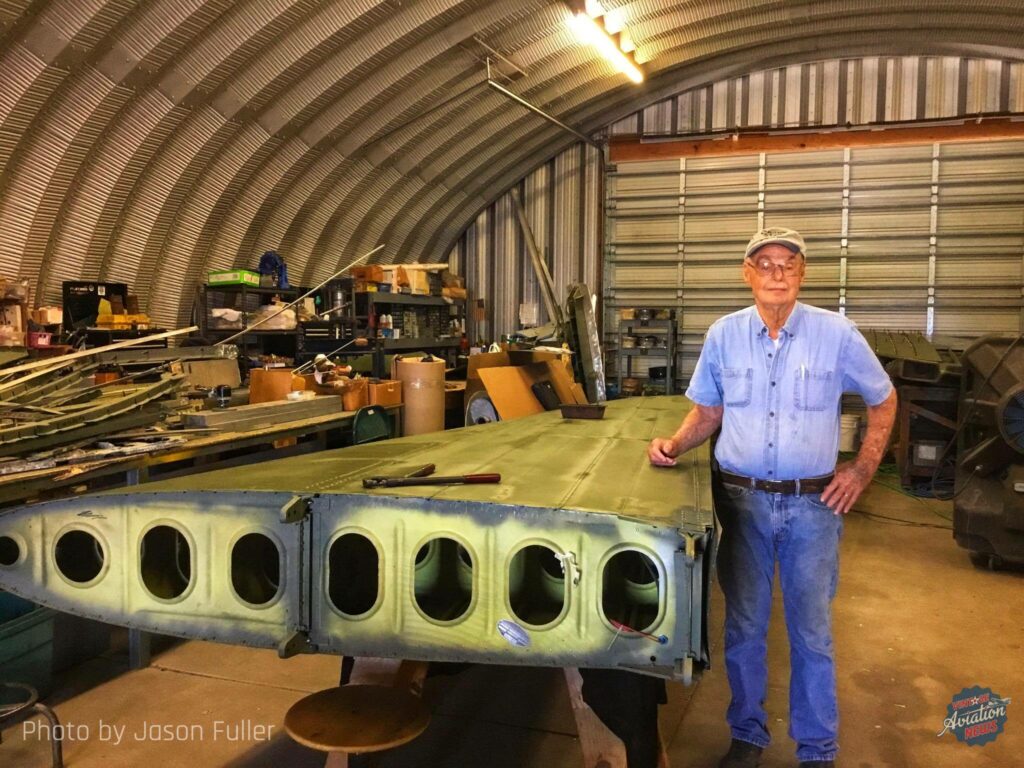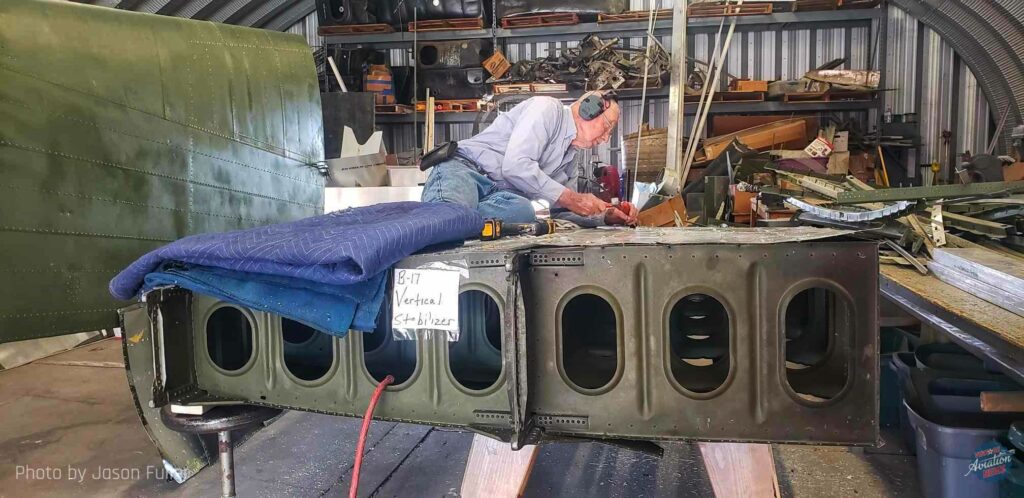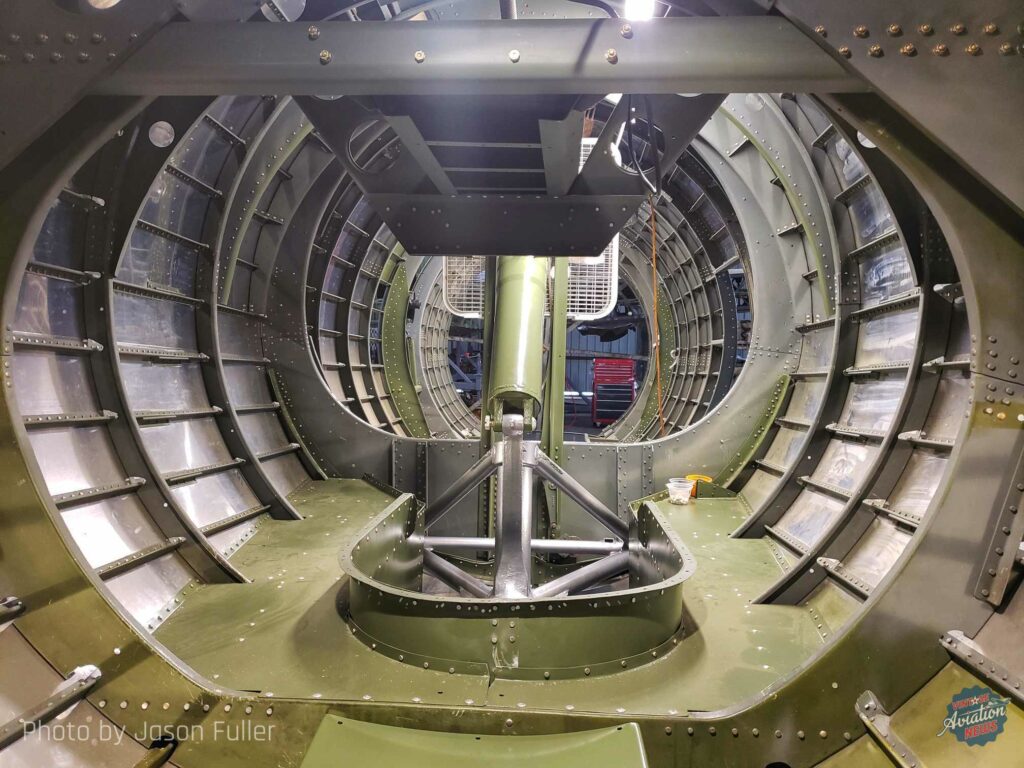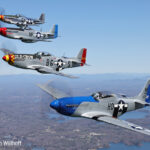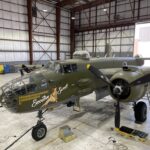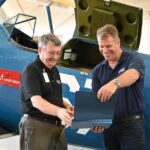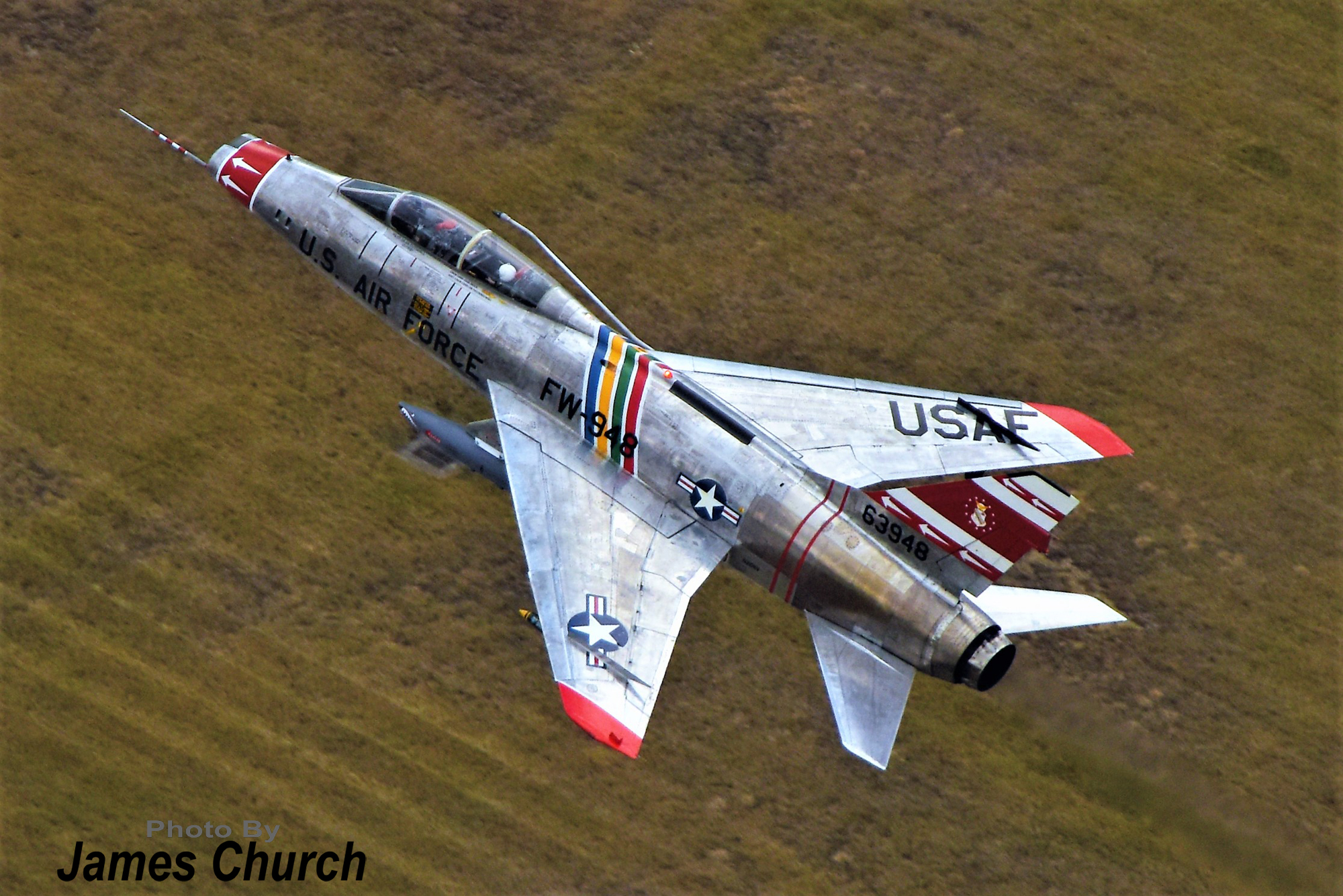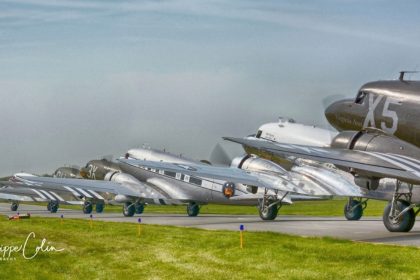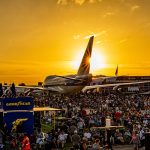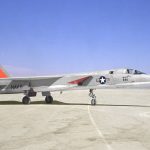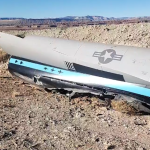by Adam Estes and Moreno Aguiari
Over the past few decades, there have been numerous occasions where a wrecked warbird once considered a total loss was eventually resurrected into airworthy condition. The B-17G known around the world as Liberty Belle is one such example. Damaged by a tornado and ravaged by fire, the Liberty Foundation’s Flying Fortress has endured a stormy flightpath, but the clouds appear to be parting once again as it edges towards the completion of its second airworthy rebuild.
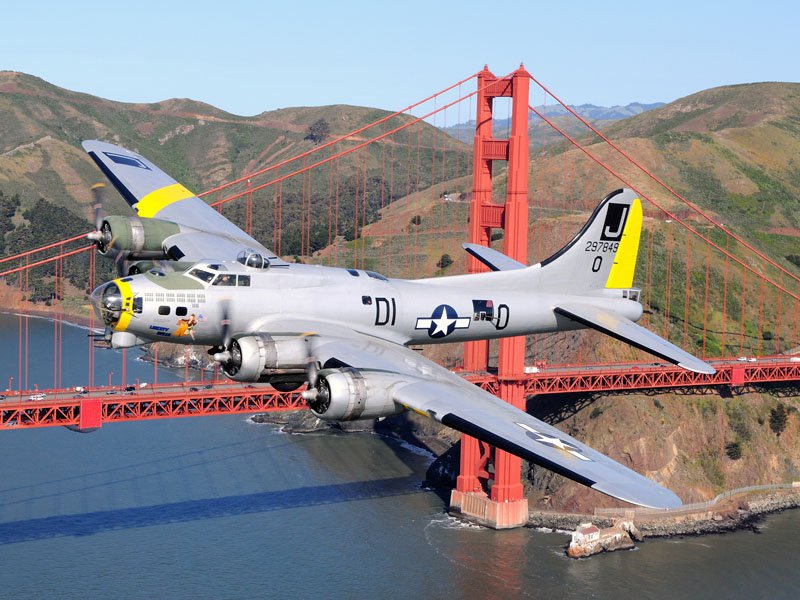
The Flying Fortress now known as Liberty Belle was one of the last B-17s constructed at the Lockheed-Vega production plant in Burbank, California. It rolled off the assembly line on May 14, 1945, and was accepted into the US Army Air Forces (USAAF) as 44-85734 two days later. Upon receiving modifications in Louisville, Kentucky, the aircraft flew into storage in Syracuse, New York on July 5, 1945. On October 12, 1945, it moved again, this time to the Reconstruction Finance Corporation’s reclamation center in Altus, Oklahoma. Given that the Altus-based Esperado Mining Co. purchased the airframe, 44-85734 could easily have become one of countless aircraft which went straight from the production line to the scrapyard; it had been part of a bid to scrap 423 aircraft on the field. However, Altus was just the first location where the aircraft encountered Lady Luck instead of the scrapper’s torch. Pratt & Whitney purchased the aircraft from Esperado, along with B-17G 44-85741, although the latter airframe, registered as N5110N, served more as a source of spare parts to keep 44-85734 (now N5111N) in the air.
During its time with Pratt & Whitney, Boeing modified N5111N’s forward fuselage to incorporate a massive, experimental turboprop engine, the T34 (which later powered the Douglas C-133 Cargomaster). In this new guise, with its cockpit pushed four feet further aft, N5111N was designated as a Boeing Model 299Z. Between 1950 and 1965, the aircraft amassed 994 flight test hours. Alongside EB-17G 44-85813, which helped evaluate the Wright T35 Typhoon turboprop, ‘One One November’ provided valuable feedback for the development of large turboprop engines.
But after fifteen years of operation, N5111N became redundant once again. On June 16, 1967, Pratt & Whitney donated the airframe to the nascent Connecticut Aeronautical Historical Association adjacent to Bradley International Airport in Windsor Locks, Connecticut. This organization, later known as the Bradley Air Museum, eventually became the New England Air Museum (NEAM) which we know today as one of the most prestigious aviation museums in the world. However, during the 1960s and 70s, much of the museum’s collection, including N5111N, was stored outdoors; exposed to the often harsh Connecticut climate. The museum’s staff did what they could with the limited funds available, but they could not have anticipated the tragedy which unfolded on October 3, 1979. A massive, F4 tornado barreled its way through Massachusetts and Connecticut, killing 3 and injuring over 500 people. The twister also ripped its way through the Bradley Air Museum, destroying sixteen of their aircraft outright, and severely damaging ten more – the B-17 being one of the latter. Grumman HU-16 Albatross (USAF 51-0025) was hurled into the air and crashed inverted onto the Fort’s waist section. Strong winds and flying debris also tore gashes into the wings of the former engine testbed. The museum began to rebuild in the storm’s aftermath, but had to focus the limited resources on its main infrastructure rather than any of the more heavily damaged exhibits. The B-17 remained in outdoor storage, awaiting future restoration.
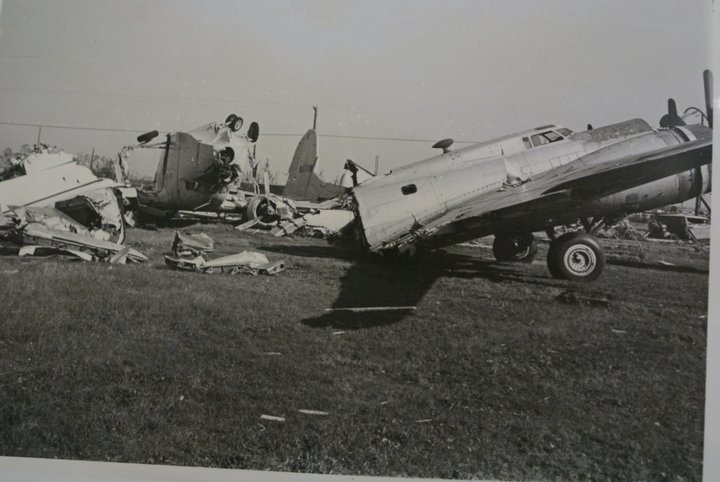
In 1988, the New England Air Museum chose to trade the B-17’s wreckage to aircraft restorer Tom Reilly, then based in Kissimmee, Florida. In return, Reilly restored NEAM’s ultra-rare B-25H Mitchell (43-4999), a fellow tornado survivor. An experienced restoration expert, Reilly had already rebuilt the Collings Foundation’s B-17G (which flew for several decades as Nine-O-Nine). Once Reilly completed the B-25’s restoration to static condition, he sent it back to Connecticut, receiving clear title to 44-85734’s remains which he then transported to his base in Kissimmee.
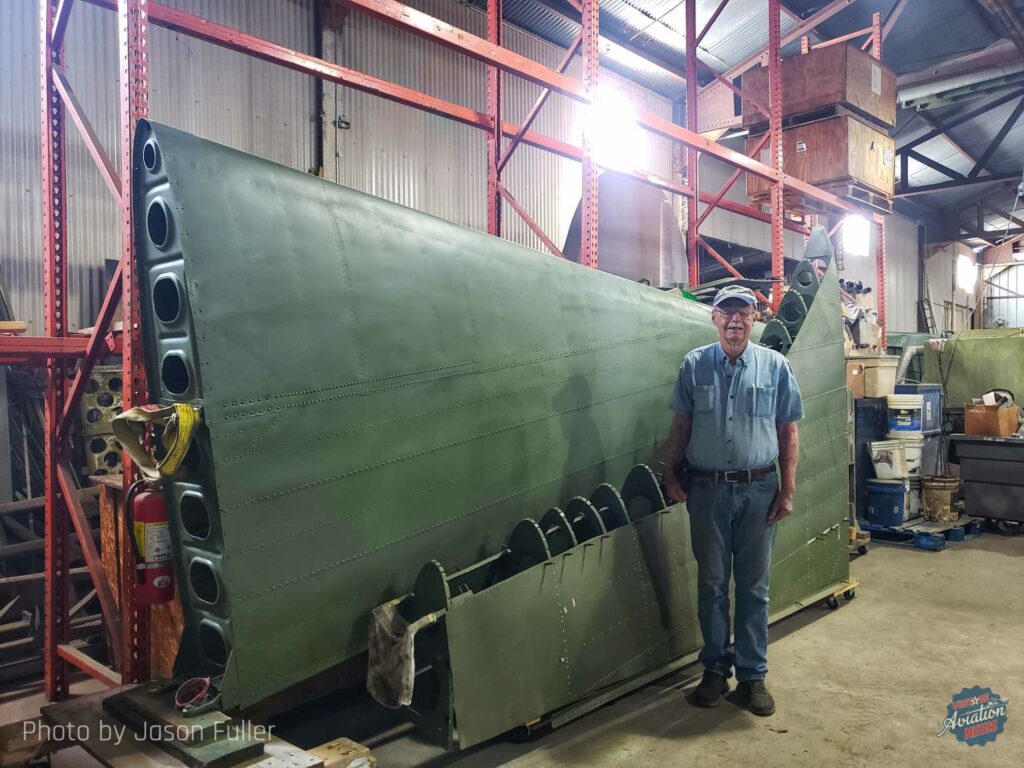
Reilly then began the daunting task of restoring this battered and much-modified Flying Fortress back to airworthy condition as a stock B-17G. However, his workshop had many other projects for paying customers which had to take priority; work on the bomber continued to progress, albeit at a relatively slow pace. By 1996, Reilly founded the group ‘Fortress Flight’ to help fund the B-17’s airworthy rebuild to represent B-17G 42-31636. Nicknamed Outhouse Mouse, that aircraft survived 139 missions over Europe with the 91st Bomb Group (BG) between March 1943 and May 1945 only to end up being scrapped shortly after the war in Kingman, Arizona.
For a brief period, 44-85734 was registered to the Randsburg Corporation of Portland, Oregon, however Don Brooks of Douglas, Georgia ended up purchasing the project in March 2003. Brooks had long wished to own an airworthy Flying Fortress as his father, Elton Brooks, had flown 35 missions as a B-17 tail gunner with the 570th BS, 390th BG from RAF Framlingham in England. Although Brooks already planned to recover B-17G 44-83790 from the bottom of Dyke Lake in Labrador, Canada, the opportunity to purchase Tom Reilly’s project was impossible for him to refuse. Brooks immediately bought the Fort and established the Liberty Foundation to maintain the aircraft upon its completion.
On December 8, 2004, 44-85734 returned to the air for the first time in over 40 years. Brooks had it painted in the markings of his father’s B-17G 42-97849 Liberty Belle. In the following year, Liberty Belle received formal approval from the FAA to operate in the Living History Flight Experience program. The aircraft then began touring the country, offering rides to thousands of people, including many WWII veterans and factory workers, some of whom applied their signatures to the aircraft. In 2008, Liberty Belle even flew to England to participate in the Flying Legends air show at Duxford, arriving at the historic airfield, quite fittingly, on July 4th. Ray Fowler and Don Brooks were at the controls when it touched down that day. With the completion of its flights around the UK, Liberty Belle returned home to continue its tour across the USA. Unfortunately, misfortune again caught up with the beautiful bomber.


Monday, June 13, 2011 started with Liberty Belle preparing to depart Aurora Municipal Airport in Sugar Grove, Illinois, some 45 miles west of Chicago. With a crew of three (pilot, copilot & flight engineer) and four volunteers aboard, Liberty Belle took off, bound for Indianapolis. During climb out, however, the crew noticed an acrid scent in the cabin, which was quickly followed by smoke billowing noticeably in the radio room. A T-6 flying as a chase plane on the flight reported seeing a fire on the underside of the left wing behind engine #2 (left inboard). The crew shut down and feathered the engine and turned back towards Sugar Grove, but as the fire grew in intensity, it soon became obvious that an off-airport landing was the only safe option available. The pilots quickly found a farmer’s field and made a successful, gear-down landing just southeast of the airport. All seven occupants escaped without serious injury. Fire trucks were called to the scene, but given the muddy conditions, they chose not to risk getting their vehicles bogged down around a burning aircraft which might explode. Left unchecked, the fire consumed most of the aircraft; just the tail and outboard wing sections survived the blaze. An NTSB investigation later concluded that a cracked fuel tank was the fire’s likely cause. Most people considered Liberty Belle to be a write-off, but Brooks was determined to see it returned to the air.

In the years since that fateful day in 2011, Liberty Belle has been under restoration in Brooks’ workshop in Douglas, Georgia. Many of the fire-damaged components were only fit for use as templates for newly-fabricated parts. Significant sections from other B-17s, such as those from the example Brooks eventually recovered from Dyke Lake, have also found their way into the rebuild. Parts from B-17G 44-83542, an ex-Aero Union tanker written off in a 1971 accident (and later salvaged as a static exhibit for Kermit Weeks at Fantasy of Flight) have also been used in Liberty Belle’s rebuild. Liberty Belle’s surviving rear fuselage, however, was sent off for rebuild with Hangar 13 in Asheville, North Carolina. Hangar 13’s owner, Ray Moore, is rebuilding his own B-17 (B-17F 42-3455 Lucky Thirteen) and has collaborated with a number of other B-17 owners in the rebuilds of their aircraft.
While much work remains to be done before Liberty Belle is ready to fly, Vintage Aviation News’ Moreno Aguiari recently interviewed Don Brooks to learn more about the long journey to revive his pride and joy for a second time.
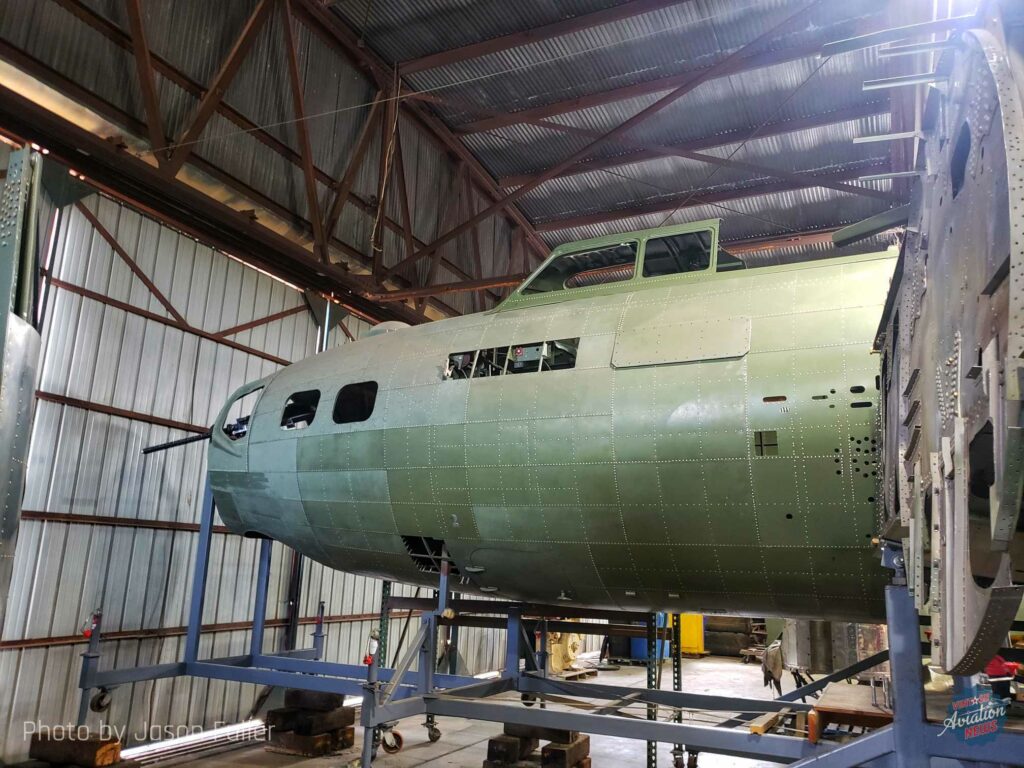
MA: “So we were just saying that after the accident, the airplane came back to Douglas and he had to face a tough decision, rebuild the airplane or not. So why don’t you take us back to those days and then I’ll ask you questions along the way.”
DB: “Yeah… after we had our fire, the plane had departed Aurora in Chicago, headed to Indianapolis. And shortly out of Aurora, while they were still in touch with departure, they had a fire start in the left wing. Of course, our crew did a great job getting the gear down, landing the plane off field, but the fire trucks couldn’t get to it and the plane burned. So severe damage, it was not destroyed, but it was severely damaged. And we eventually were able to truck the parts back to Douglas, Georgia and we didn’t do anything for several months. And then we made the decision that we wanted to rebuild the airplane and continue to fly and let people enjoy it all over the U.S. So, we disassembled it completely, made notes of the parts that were fire damaged, the ones that were not, and then we slowly started to rebuild on it.
We had other projects in process at the time, so it was a number of years before we really started in earnest focusing on the Liberty Belle. But we’ve made good progress. It takes a lot of work to get the big parts rebuilt. So, you build a piece and you put it aside until you’re going to need it. And finally, when you get enough of the parts and you assemble some major assembly to the airplane, it looks like you’ve been doing something, and you show progress. But to date, we’ve rebuilt the outer wing panels from the original Liberty Belle. Those are completely redone and ready to go back on the airplane.”
“The inner wing panels were of course, the most badly damaged part of the airplane, that and the center section of the fuselage. But the inner wing panels, we decided rather than rebuild the originals, that we would use the other wing inner panels. And we have two of those in 19… 2004, I recovered a B-17 out of Dyke Lake in Labrador and we used a left inner wing panel from that Dyke Lake B-17 and completely took it apart. It had been under freshwater for 50 years and we completely disassembled it. Every rivet came out. We dropped down to the basic spar tubes. The spar tubes were inspected, and they were in very good shape. They had no cracks, no bad corrosion. And we started building that wing back up and it’s ready now to install on the aircraft.”
“The right-wing panel is one that I obtained that at one time, was on Shoo Shoo Baby, the B-17 that’s at the Air Force Museum in Dayton. And when that aircraft was rebuilt, they elected to put new wings on it. So, they were disposing of the old parts. This was many, many years ago, way before we were rebuilding the Liberty Belle, it was obtained by somebody else. Anyway, I bought the right inner wing panel and then we disassembled it and again, checked for corrosion, and any cracks. Again, thankfully the spars were good, no cracks. But that right inner wing panel now has been completely rebuilt and it’s ready to install on the aircraft.
The Flat bays, which are a trailing edge of the inner wing panels have been rebuilt. The ones of the Liberty Belle were used and they’ve been totally rebuilt now, and they’re ready to be installed on the inner wing panels as soon as we have the inner wing panels permanently attached to the center fuselage. So those are some big parts. For all of the inner wings, flat bays, and outer wing panels, we’re using our original wing tips. So, all of that is complete and ready to go on the airplane.
In the fuselage, we used parts that we could obtain. We had several other donor aircraft, but we have now completely rebuilt the forward fuselage with the exception of the top of the cockpit. And it goes back over the bomb bay and all the radio rooms. We’re in the process of fabricating all of the top of the cockpit area in the top section of the fuselage and then beginning to install those on the forward fuselage. So, the forward fuselage, it’s probably 90% ready and that includes, of course, the bomb racks, which are structural and everything inside of the fuselage.
We’re also now working on the tail section. The natural brake on the B-17 fuselage is right behind the radio room where it bolts together. So, Ray Moore in Asheville, North Carolina did most of the work on our tail section and we received it last year and we have to finish it up. It was not 100%, but we had several donor aircraft tail sections. So, most of the heavy parts in the tail section are all original, but of course, they too had to come apart and be cleaned and sandblasted or glass blown and shelled and reprimed, and mostly new skin on the tail although some of the rear section of Liberty Belle was good enough that it didn’t have heat damage and we were able to use most everything after the crew doors. We also used the original Cheyenne tail turret of the Liberty Belle.
So, most of that’s going back together now, and hopefully, within the next six months, our goal is to have the forward fuselage and the rear fuselage bolted together. And we hope to have the inner wing panels set and permanently attached by mid or late this year as well. So, our progress is really coming along very well. Tom Riley is overseeing the project. Tom says that it’ll take about a year once the plane is basically together, it’ll take about a year to do systems on the aircraft. All four of these engines will need to be overhauled. They were low-time engines; they did not have any sudden stoppage. So it may be that we can IRAN the engines rather than do a complete overhaul because they were low-time and in excellent condition and they didn’t have any sudden stoppage.”
“So anyway, we will start working on the firewall forward for the engines before long, we’ll build them up and have them ready when we get the plane together. But a lot of the other smaller sub-assemblies are done, the four original engine nacelles have been totally rebuilt, and particularly the inboards had quite a bit of damage from fire and we had to replace a lot of those heavy parts. But the four engine nacelles are ready now to go in the aircraft. We don’t want to install those back on the wings until the center section, the inner wing panels are permanently attached.”
“All three landing gear have been completely apart and rebuilt. They’re ready to go on. We’re getting to the point now for another six months, we’ll still be fabricating some parts, but probably the last half of this year, it’ll be mostly putting the big parts together and it’ll shape up in a hurry at that time. Before the end of 2024, we expect to have the inner wing panels on the complete fuselage and put the landing gear under it so we can have the aircraft back on its gear before the end of this year.”
MA: Fantastic!
DB: “And we have the horizontals from Liberty Belle. One of those has been repaired, and the other one is in process now. So, we’ll use the original horizontals. All of the control surfaces, the ailerons, elevators, and rudders from the Liberty Belle have all been repaired and are now recovered through silver. So, the controlled surfaces are ready to go back home when we need them. Anyway, we’ve done a lot of work that doesn’t really show, and if anybody’s ever down in the Douglas, Georgia area, I’d be glad to show you through the airplane. Our guys are usually there every weekday, and Douglas is home to the World War II Flight Training Museum, which is open on the weekends, and they have access to our hangars. So, if anybody likes, they can come down and go to the World War II Flight Training Museum and they’ll take them over to our shops and show them our projects and the B-17.
And it’d be good if anybody would like to see that website, it’s World War II Flight Training Museum (wwiiflighttraining.org). So about 10,000 Army Air Corps pilots were trained here during World War II and our museum tells the story of our Douglas Air Base during World War II. And of course, a lot of people are excited about the new “Masters of the Air” miniseries that came out early this month. The central character in that series is Robert Rosie Rosenthal with the 100th Bomb Group. And of course, Robert Rosie Rosenthal learned to fly here in Douglas. That’s where he did his primary flight training.
So… we’re excited about that and look forward to seeing it.”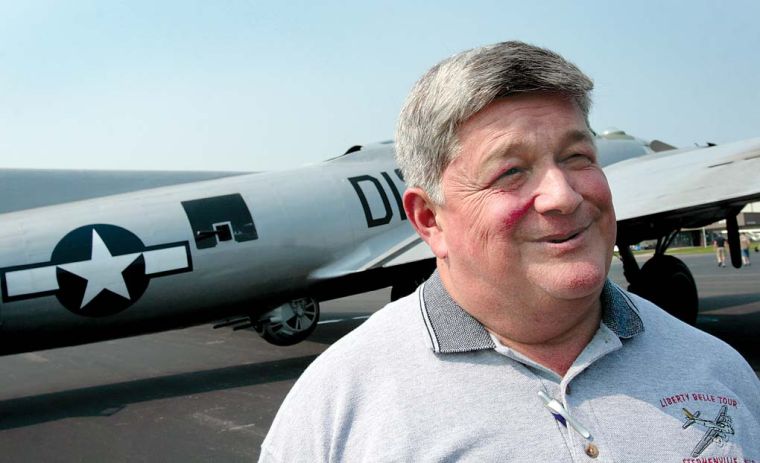
MA: “Just one more question that I want to put on the record, because I think it’s very important to you since there is a specific reason why you’ve been flying, restoring, and supporting the B-17 mission… it’s because your father was a B-17 crew member in World War II, correct?”
DB: “That’s correct. My father was a tail gunner on the original Liberty Belle that flew in the 390th Bomb Group out of Framingham, England. He flew 35 missions and made it home safely. Three of his crew members were killed and didn’t make it back. And so, I grew up hearing some of the stories. He never liked to talk about the things that he said he spent the last 30 years of his life trying to forget. But as I got older, he would tell me some of those stories because he knew I was interested. But I think the more that anybody learns about what those veterans did for us during World War II, the dedication and sacrifice, the more that we all realize that we need to keep the memories alive. And rebuilding this airplane, flying it all over the U.S. and we have taken it to the UK and Canada, people still remember our airmen and they remember them giving their lives for the freedom really, of the world, not just the United States.”
MA: “100%.”
DB: “…When you watch ‘Masters of the Air’, you’ll see. It’ll help people to realize how great these guys were and the tremendous sacrifice that they made for our freedom. So I was fortunate to have a father who was also a hero, so at least he was my hero.”
To support The Liberty Foundation’s efforts to return the Liberty Belle to the air, visit, The Liberty Foundation Inc – Liberty Foundation







